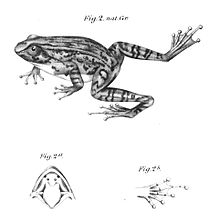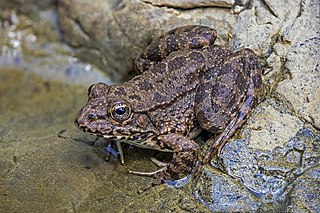
True frogs is the common name for the frog family Ranidae. They have the widest distribution of any frog family. They are abundant throughout most of the world, occurring on all continents except Antarctica. The true frogs are present in North America, northern South America, Europe, Africa, and Asia. The Asian range extends across the East Indies to New Guinea and a single species, the Australian wood frog, has spread into the far north of Australia.
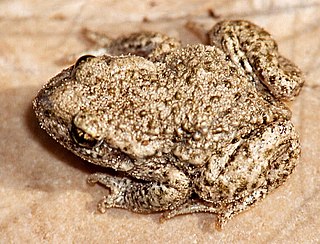
The Alytidae are a family of primitive frogs. Their common name is painted frogs or midwife toads. Most are endemic to Europe, but three species occur in northwest Africa, and a species formerly thought to be extinct is found in Israel.

The Arthroleptidae are a family of frogs found in sub-Saharan Africa. This group includes African treefrogs in the genus Leptopelis along with the terrestrial breeding squeakers Arthroleptis, and several genera restricted to the Guinean forests of central and west Africa, such as the hairy frog (Trichobatrachus).

Conraua, known as slippery frogs or giant frogs is a genus of large frogs from sub-Saharan Africa. Conraua is the only genus in the family Conrauidae. Alternatively, it may be placed in the family Petropedetidae.
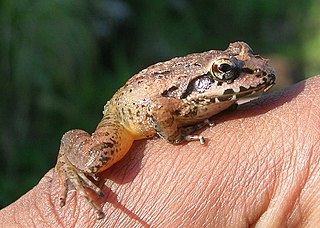
Indirana is a genus of frogs in the family Ranixalidae. These frogs are endemic to the Western Ghats of India. They are sometimes known under the common name Indian frogs, whereas members of their parent family are named "leaping frogs".
Arthroleptides is a small genus of frogs in the family Petropedetidae. Their common name is rocky river frogs. They are found in the mountains of East Africa. They have been considered to belong to Petropedetes, which after exclusion of Arthroleptides is restricted to Central Africa.
The Usambara torrent frog, also known as Martienssen's torrent frog or Tanzania rocky river frog, is a species of frog in the family Petropedetidae. It is endemic to the Usambara Mountains of Tanzania, where it is found 200–1,000 m (656.2–3,280.8 ft) above sea level. It is one of many, often taxonomically unrelated, frogs referred to as torrent frogs. It is mostly grey brown to yellowish brown, with a lighter underside and a dark stripe extending from the nostril to the shoulder, and can grow 59 mm (2.3 in) long.

The southern torrent frog is a species of frog in the family Petropedetidae endemic to Tanzania, where it is found in the Uluguru, Udzungwa, and Mahenge Mountains. Frogs from the Nguru Mountains may represent an unnamed species.

Petropedetes is a genus of frogs in the family Petropedetidae, found in sub-saharan tropical Africa. In 2002, the genus absorbed all three species of the genus Arthroleptides, but they were moved back in 2014. The informally assigned common name for frogs in this genus is torrent frogs.
Petropedetes parkeri is a species of frog in the family Petropedetidae. It is found in western Cameroon and eastern Nigeria. Records from Equatorial Guinea and Gabon are uncertain, possibly belonging to Petropedetes euskircheni. P. parkeri is named after Hampton Wildman Parker, a British zoologist and herpetologist from the Natural History Museum, London. Common names Parker's water frog and Parker's torrent frog have been proposed for it.
Petropedetes perreti is a species of frog in the family Petropedetidae. It is endemic to Cameroon. It is known from the southern slopes of the Bamiléké Plateau, Mount Manengouba, and Mount Nlonako. Common name Perret's water frog has been coined for it.

Phrynobatrachus is a genus of Sub-Saharan frogs that form the monogeneric family Phrynobatrachidae. Their common name is puddle frogs, dwarf puddle frogs, African puddle frogs, or African river frogs. The common name, puddle frog, refers to the fact that many species breed in temporary waterbodies such as puddles.
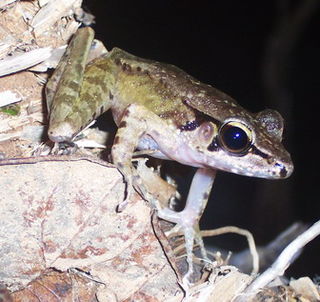
Torrent frogs are a number of unrelated frogs that prefer to inhabit small rapid-flowing mountain or hill streams with a lot of torrents. They are generally smallish neobatrachians with a greyish-brown and usually darkly mottled back, giving them excellent camouflage among wet rocks overgrown with algae; their well-developed feet make them agile climbers of slippery rocks.

Nyctibatrachidae is a small family of frogs found in the Western Ghats of India and in Sri Lanka. Their common name is robust frogs. Recognition of Nyctibatrachidae as a family is fairly recent. These frogs were previously placed in the broadly defined family Ranidae, which was more recently divided into three subfamilies: Lankanectinae, Nyctibatrachinae, and Astrobatrachinae.
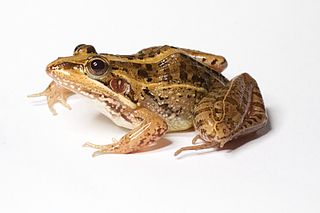
Ptychadenidae is a family of frogs commonly known as the grassland frogs. These frogs occur in Sub-Saharan Africa.

Craugastoridae, commonly known as fleshbelly frogs, is a family of New World direct-developing frogs. As delineated here, following the Amphibian Species of the World, it contains 129 species. They are found from the southern United States southwards to Central and South America.
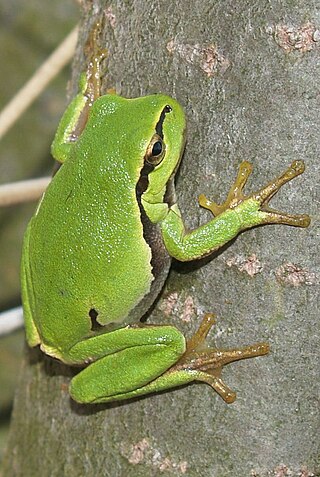
Hylinae is a large subfamily of "tree frogs", family Hylidae.

Odontobatrachus is a genus of frogs comprising the family Odontobatrachidae. In a 2014 research project Barej, Rödel, Loader & Schmitz separated the genus from the established genus Petropedetes and separated the new family from the established family Petropedetidae.

The Alsodidae are a small family of frogs from South America between Patagonia and southern Brazil. It contains 30 species in three genera. This family, along with several other families, used to be included in the family Leptodactylidae. It was then a subfamily in the family Cycloramphidae, before being recognized as a family first in 2011.

Hylodidae, commonly known as giant Neotropical torrent frogs, is a family of frogs native to Brazil and northern Argentina. Phylogenetic evidence suggests the Hylodidae being the sister group to the Alsodidae.
